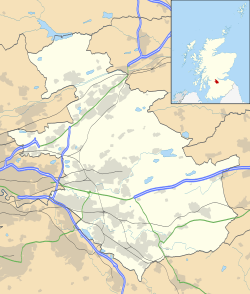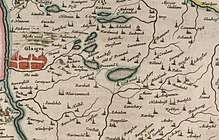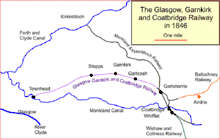Gartcosh
Gartcosh (Scottish Gaelic: Gart Cois) is a village in North Lanarkshire, Scotland. The village lies a few miles east of Glasgow (the closest settlement in the city boundaries being the village of Gartloch), and about a mile northwest of the town of Coatbridge.[1]
Gartcosh
| |
|---|---|
.jpg) Gartcosh from the air (2018) | |
| Population | 2,130 Estimate Mid 2012 |
| Lieutenancy area | |
| Country | Scotland |
| Sovereign state | United Kingdom |
| Post town | GLASGOW |
| Postcode district | G69 |
| Police | Scotland |
| Fire | Scottish |
| Ambulance | Scottish |
| UK Parliament | |
| Scottish Parliament | |
According to a 2012 estimate, the population of Gartcosh was 2130.[2] Expansion of the village including 300 homes in the Heathfield Park estate built by Redrow Homes[3] has increased the population.
History
The name Gartcosh might be derived perhaps from the Gaelic 'Gart' meaning 'field' and 'Cos' meaning 'hollow'. Alternatively "enclosure of the foot" has been suggested.[6] Several old documents show Gartcosh (spelled Gartcash) including maps by Pont, Forrest,[7] and William Roy.[8]
Though originally an agricultural village, Gartcosh is better known for its role in Scottish industry.[9] In the early 19th century there were a number of mines in the local area, and the first railway to service Gartcosh was used to transport coal to Glasgow. By 1837 there was a railway station, or to be more accurate a stopping place as there were no platforms or waiting rooms.
From the mid-19th century onwards, Gartcosh became prominent in industry with the opening of iron works[10] and fireclay works.
Gartcosh Fireclay Works was established by James Binnie in 1863. Although mostly concerned with firebrick manufacture, during the early years its output was much more varied, extending to garden vases and pedestals, garden edges, fountains, chimney cans, roof tiles, cattle troughs, sewage pipes and other products.[11] It was one of a group of such businesses in the area, with others at Cardowan, Garnkirk, Cumbernauld, Heathfield and Glenboig.[12] The fire clay works at Garcosh at the end of the 19th century was owned by the Glenboig Union Fireclay Company Limited.[13] Gartcosh Fireclay Works eventually closed down in the 1950s, when local supplies of fireclay were exhausted.
In 1865 Gartcosh became the home of Woodneuk Iron Works owned by William Gray & Co. It was bought by Smith & McLeans in 1872 and subsequently Colville's steel mills. British Steel Corporation took ownership of the Colville's steel mill in Gartcosh in 1967 and operated until its closure in February 1986. The main steel mill building was demolished around 1994-95. The galvanising plant - latterly a storage shed for oversized products produced in the mill building - was used by a paper recycling company, Stirling Fibre, between October 1990 and October 2001. After this company relocated, the building was demolished in 2002.
Smith & McLeans had considerable trouble purchasing the land for the extension of the steelworks from the original land owners. Most of Gartcosh at the time was owned by two strict presbyterian spinster sisters who were unswayed by the considerable financial offerings of the company. They eventually relented, on the condition that no public house, betting shop or Catholic church would ever be housed within the Gartcosh boundaries. This agreement still holds to this day.
For this reason, Chapman's public house is built immediately outside of the natural boundary of Gartcosh (a small burn running to Glenboig). In the 1960s, there was a successful application for licensed premises, under the label of Gartcosh Works Social Club. There has never been a licensed bookmakers in Gartcosh. The resident Roman Catholic population travel to the neighbouring towns of Muirhead, Glenboig or Coatbridge to practise their faith.[14][15]
The Co-operative store was established in the late 19th century, situated at the junction between Old Gartloch Road and Lochend Road. The store closed down, date unknown, and has had a variety of uses since then. The building, known locally as the old Co-op Building, has 3 flats above the shop which are now privately owned and occupied.
Gartloch Hospital was opened as in 1896. It was built on the Gartloch Estate which had been bought by the Glasgow City Council for nearly £8,600. It was then handed over to the Glasgow District Lunacy Board as a site for an asylum for the poor people of the Glasgow.[16]
Present day
.jpg)
.jpg)
Gartcosh is now primarily a residential area. In recent years, new housing developments by Redrow Homes, Thomas Mitchell Homes[17] and other smaller developers have taken place in and around the old village. There are plans for further developments in the surrounding areas of farm land.
Gartcosh Business Interchange is currently being developed on the site of the old strip mill and steel works. As of 2006, Scottish Enterprise and North Lanarkshire council had invested £18m on land reclamation and upgrading transport access.[18] This project will provide over 170,000 square metres (1,800,000 sq ft) of business space serviced by the transport links detailed below.
The new Scottish Crime Campus is currently being developed within Gartcosh Business Interchange. The development of this facility was originally administered by the Scottish Police Services Authority but following police reform in 2013 all of their undertakings, including the Crime Campus, were transferred to the Scottish Police Authority. The facility was originally scheduled for completion in 2010 with cost of the development put at approximately £65 million.[19] However at date of current entry (April 2013) the budget for the project was estimated at £82 million and the facility is still under construction and to be internally fitted and the revised estimated date of full occupation is some time in early 2014.[20] The crime campus will house elements of several of Police Scotland's partner agencies in the Criminal Justice system at Serious and Organised Crime level. These are parts of the Crown Office and Procurator Fiscal Service, the National Crime Agency (including the Serious Organised Crime Agency), HM Revenue and Customs and the SPA Forensic Laboratory for the Glasgow area.[21]
Next to the campus is the Gartcosh Local Nature Reserve. Although relatively small in area, it includes a variety of wildlife including protected species such as a great crested newt colony (the largest in Scotland).[22]
There is a Church of Scotland parish in Gartcosh which has Bible Study, Sunday services and a Sunday Club for youngsters. The church hall is utilised for various community projects including 1st Gartcosh Boys' Brigade and both slimming and exercise groups.[23]
The defunct Anglican church at the top of the hill on Lochend Road was demolished in 1997 for property development.
The original Gartcosh Police Station closed in the 1990s however most of Gartcosh continues to be served by Cumbernauld Sub Division of Police Scotland. Gartcosh Railway Station and its access roads, Chapman's Public House and a small number of houses in the village to the south of the railway line are served by Monklands Sub Division, operating from Coatbridge Police Office. Gartcosh has some of the lowest crime rates in the Lanarkshire Division.
Gartcosh is home to the Caledonian Amateur Football league team Gartcosh United. Founded in 1962 by George Dingwall, the team has developed many professional players over the decades including Pat Nevin, Dave McPherson, Derek Ferguson and more. The club’s current Board include Chairman, David Quate, Ex-professional footballer Brian Smith, Scottish entrepreneur Gavin Muir and Adidas executive Andrew Barr.[24]
In 2008, the old Co-Op building on Old Gartloch Road was acquired from the previous owner by Harlequin Leisure Group and work commenced on fitting these premises into a number of separate units. These premises are now home to the Reach Pharmacy, Hair Salon, "Chin Chin" (formerly "Asia") restaurant, and a grocer's shop.
Current local services in Gartcosh include:
- Licensed Village Shop
- Reach Pharmacy
- Hair salon
- Grocers shop
- "Chin Chin" Chinese/Asian restaurant and takeaway
- Gartcosh Works Social Club
- Gartcosh Primary School
- Lochview Children's Nursery
- Plant Nursery
- Tea House On The Loch
- Architectural Services "Scotdraw Architectural Services"
Future development
.jpg)
North Lanarkshire Council have identified open space areas around Gartcosh and Glenboig as potential sites for a "Community Growth Area". This, in effect, means there is potential for up to 3000 homes in total to be built in Gartcosh and Glenboig, of which approximately 1800 are to be built in the Gartcosh area alone. At least 25% of this must be "affordable housing". Provisions will be made for infrastructure and amenities to support such a large development. Such a development will have significant impact on the local landscape with much of the green belt and farmland being developed into housing and retail areas.[25]
Plans for a new road between Gartcosh and Glenboig were approved in 2016.[26] This road opened June 2018. New homes are being built at Gartcosh with the first of the 78 due in 2018.[27]
Transport
General Transport Information
The M73 motorway is the main transport link, with Junction 2A providing road access to the village. Gartcosh also benefits from a railway station which was built at a cost of £3.5 million and officially opened in March 2005 by Princess Anne.
Road and Rail Links
- M73 - north to A80(M) providing motorway access to North Glasgow, Cumbernauld, Falkirk, Stirling and The North
- M73 - south to M74 providing motorway access to South Glasgow, Hamilton, Motherwell, Carlisle and The South
- A752 - north to Muirhead
- A752 - south to A89 providing access to Coatbridge and Baillieston and continuing south to Uddingston and Bothwell
- A752 - south to A8(M) providing motorway access to Edinburgh, Glasgow and the Central Belt.
- B806 - West to Glasgow Fort Shopping Centre
- Gartcosh railway station providing direct rail service to Glasgow Queen Street, Cumbernauld and Falkirk Grahamston, and to Edinburgh via either Glasgow or Falkirk stations.
On film and TV
- The Big Mill (1963) colour, sound 25 mins - dir. Laurence Henson shows steel being produced at Ravenscraig and Gartcosh[28]
- Make Way For Steel (1966) colour, sound 29 mins by Templar Film Studios shows the building of the steel works at Ravenscraig and Gartcosh[29]
References
- "OS 25 inch, 1892-1905". National Library of Scotland. Ordnance Survey. Retrieved 9 June 2017.
- "Estimated population of localities by broad age groups, mid-2012" (PDF). Retrieved 3 January 2018.
- "TV appearance for Redrow's Gartcosh homes". Easier. 4 December 2008. Retrieved 28 November 2011.
- Blaeu, Joan. "Glottiana Praefectura Inferior". National Library of Scotland. Retrieved 30 December 2017.
- "Hal of Gaetcaish on Pont 34". Maps of Scotland. Timothy Pont (16th century). Retrieved 31 December 2017.
- Drummond, Peter, John (2014). An analysis of toponyms and toponymic patterns in eight parishes of the upper Kelvin basin (PDF). Glasgow: Glasgow University. p. 163. Retrieved 3 July 2017.
- "Old County Maps". NLS. Retrieved 27 January 2018.
- "Roy's map of the Lowlands". NLS. Retrieved 27 January 2018.
- "IN & AROUND GARTCOSH- Industries". The Gartcosh Local History Group. Retrieved 1 March 2018.
- Macdonald's Scottish directory and gazetteer. Edinburgh: W. MacDonald & Co. Ltd. 1884. p. 241. Retrieved 28 February 2018.
- Jewitt, Llewellynn Frederick William (1878). The ceramic art of Great Britain from pre-historic times down to the present day : being a history of the ancient and modern pottery and porcelain works of the Kingdom, and of their productions of every class. London: Virtue. p. 508. Retrieved 28 February 2018.
- Mort, Frederick (1910). Lanarkshire. Cambridge: Cambridge University Press. p. 88. Retrieved 28 February 2018.
- Turner, John A. Brickmaking in the land o' Scots (Brick and Clay Record, Volume 11, Issue 4 ed.). Chicago: Windsor and Kenfield Pub. Co. pp. 166–168. Retrieved 28 February 2018.
- "Monklands Memories- Gartcosh". Monklands.co.uk. 1 March 2007. Retrieved 28 November 2011.
- "Gartcosh | Towns and Villages | Places". Visitlanarkshire.com. Retrieved 28 November 2011.
- http://www.hiddenglasgow.com/Asylums/Gartloch.htm
- "The Leading Thomas Mitchell Home Site on the Net". thomasmitchellhomes.com. Retrieved 28 November 2011.
- http://www.tritax.co.uk/news.php?id=42%5B%5D
- http://www.scotland.gov.uk/News/Releases/2009/04/14093937
- "New crime campus at Gartcosh gives a boost to Scottish companies". Kirkintilloch Herald. 18 April 2012. Retrieved 20 April 2012.
- http://www.scotland.gov.uk/Topics/Justice/crimes/organised-crime/soc/ScotCrimeCampus
- "Gartcosh Nature Reserve". Retrieved 16 May 2012.
- "Gartcosh Parish Church". Gartcoshchurch.co.uk. Archived from the original on 3 March 2012. Retrieved 28 November 2011.
- "GartcoshUnited.com". Gartcosh United. Archived from the original on 14 March 2012. Retrieved 28 November 2011.
- "Gartcosh:Glenboig Community Growth Area concept statement (April 2010)". North Lanarkshire Council. Retrieved 28 February 2018.
- Bargh, Andrew (20 October 2016). "Work set to start on new £6.6m link road between Gartcosh and Glenboig after deal ratified". Daily Record. Retrieved 28 February 2018.
- "Avant to build 78 new homes at £20m development in Gartcosh". Scottish Construction Now. 13 September 2017. Retrieved 28 February 2018.
- "The Big Mill at the Moving Image Archive". National Library of Scotland.
- "Make Way For Steel at the Moving Image Archive". National Library of Scotland.





